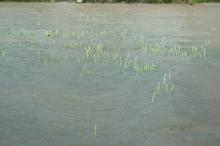Information Possibly Outdated
The information presented on this page was originally released on May 6, 2011. It may not be outdated, but please search our site for more current information. If you plan to quote or reference this information in a publication, please check with the Extension specialist or author before proceeding.
River waters invade adjacent cropland
MISSISSIPPI STATE -- Farmers were gambling along the Mississippi River long before casinos were built, but as they watch water flood over their fields, all bets are off.
The river is predicted to crest in Vicksburg around May 20 at 57.5 feet, which is 14.5 feet above flood stage and 6 feet above the previous record.
Robert Martin has been watching the mighty Mississippi and its tributaries ebb and flow past Delta fields for 40 years. He is the Sharkey and Issaquena county director for the Mississippi State University Extension Service.
“The crest will depend on rainfall within the backwater system and on the levees. If there is a breach in the Yazoo Backwater Levee, virtually all of Issaquena and Sharkey counties will be flooded, plus parts of several surrounding counties,” Martin said. “If everything holds as it is expected to do, we are looking at 15,000 to 20,000 acres of farmland in these counties impacted by this flood.”
Martin said the fields planted in corn will be lost. Some fields may be planted in soybeans after the water recedes, which could push planting as late as July.
“The river is not expected to be below 50 feet (at Vicksburg) before June 15 because of the release of the reservoirs north of Memphis that are currently being held to decrease the flow as much as possible,” he said. “Virtually all of the Delta area of Warren County will be flooded and planted late, if at all.”
Tom Eubank, assistant research and Extension professor at the MSU Delta Research and Extension Center in Stoneville, said soybean farmers typically plant in April and May.
“Yields tend to go down when weather delays soybean plantings until June or July. It will be a gamble, but soybeans can be planted as late as July. My granddad was around for the 1927 flood, and he always said the best cotton crops were after floods,” Eubank said.
Of particular concern may be the supply of soybean seed available for planting after the floods recede.
“Many of the acres that were planted in corn prior to the flooding will likely be planted in soybean now,” he said.
Wayland Hill, hydraulic technician with the U.S. Army Corps of Engineers in Vicksburg, said about 370,000 acres of cropland is forecast to go under water. The primary counties at risk are Yazoo, Humphreys, Sharkey, Issaquena, Warren, Jefferson, Wilkinson and Adams.
Hill said two counties not along the Mississippi River had a record flood at the end of April.
“Quitman County had 105,000 acres along the Coldwater River, and Tallahatchie County had 26,500 acres flood along the Tallahatchie River when 12 to 15 inches of rain fell in 18 hours,” Hill said.
Don Respess serves as the county director for Coahoma and Quitman counties. He said water is already standing in most wheat fields. Some spring plantings are also underwater in the lower portions of the fields.
“We were off to such a good start it makes all this water even more depressing,” Respess said. “Most farmers had their wheat booked, and that brings on more problems.”
Extension agricultural economist John Michael Riley said farmers who forward contracted their crops could have to look elsewhere for their supply if their own crop is not harvestable. Wheat is the most vulnerable crop right now.
“The national average of farmers who contract their crops is pretty wide – between 10 percent and 50 percent,” Riley said. “Mississippi farmers are probably on the lower end of that percentage because of crop diversity. Still, more of them are using these tools compared to 10 years ago.
“Farmers do not typically lock in all their wheat, only a small percentage,” he said. “They estimate what they will produce based on yields from several years.”
Given the scope of this flood, there is not much of a silver lining for farmers, but if there is one, Riley said it is crop insurance.
“Depending on the odds of crop losses, an increasing number of farmers may have crop insurance to provide some assistance,” he said. “Farm programs require some level of insurance, and so most producers will be covered. However, not all of the damage will be insured, and the delays to planting will further reduce potential profitability.”













